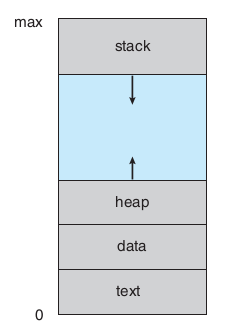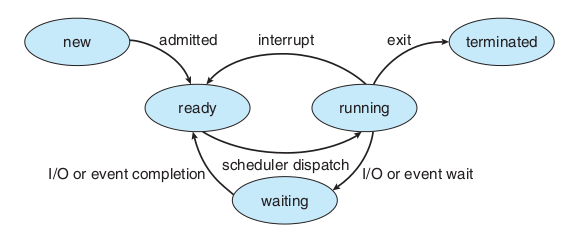刚好最近在准备找工作面试,无奈之前的基础知识已经遗忘殆尽,值得在重新复习一下,便做了关于操作系统方面的笔记,书采用的是Operating System Concepts, 9th Edition,采用边看边做笔记的形式来记录下,以便以后遗忘时可以随时查验。全篇将近有1000页不可能全部看完,只得分批来看,今天主要看进程模块。
Process(进程)
程序的组成主要包括一下几个部分: * text section: it contains the program code, program counter and registers information. * stack section: it contains the temporary data, such as function parameter, return address, local variables. * data section: contains the global variables. * heap section: for dynamically memory allocations during the process run.
Also the following figure show the common program structure in memory. 
进程状态和进程控制块(Process Control Block)
进程主要有如下几种状态,分别为:
* New: the process is being created.
* Ready: the process is waiting to be assigned to the processor.
* Running: Instructions are being executed.
* Terminated: the process has finished execution.
* Wait: The process is waiting for some event to occur (such as an I/O completion or reception of a signal).
And the following figure show the work flow of process state.

进程的创建
子进程创建继承父进程的资源信息,接下来可以利用exec()函数来覆盖父进程的进程空间,执行自己的进程,也可以保持父进程的执行空间,使的父子进程同时执行。一个经典的创建多进程的实例如下:
#include <sys/types.h>
#include <stdio.h>
#include <unistd.h>
int count = 0;
int main()
{
pid_t pid;
/* fork a child process */
pid = fork();
while(count < 10) {
if (pid < 0) { /* error occurred */
fprintf(stderr, "Fork Failed");
return 1;
}
else if (pid == 0 && (count%2 == 0)) { /* child process */
printf("Child Execute: %d\n", count);
}
else if (pid > 0 && (count % 2 == 1)){ /* parent process */
/* parent will wait for the child to complete */
printf("Parent Execute: %d\n", count);
}
count++;
}
return 0;
}进程间通信 主要有两种常见的进程间通信的方式,Shared Memory 和 Messaging Pass。